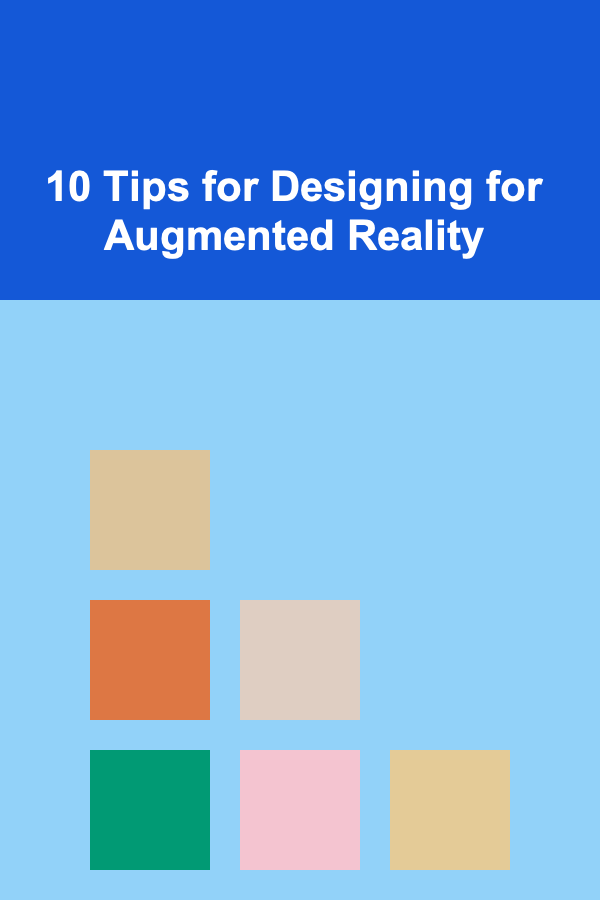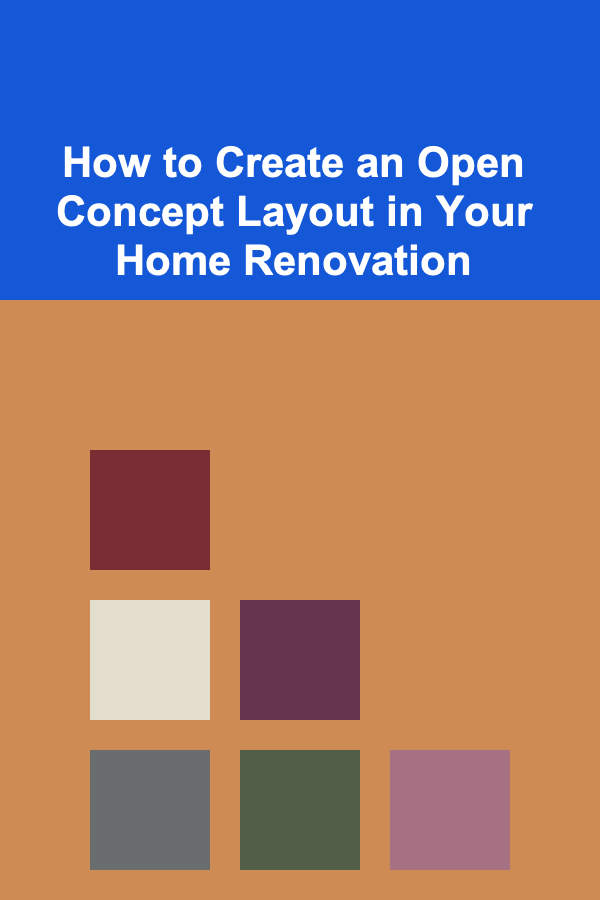
10 Tips for Designing for Augmented Reality
ebook include PDF & Audio bundle (Micro Guide)
$12.99$11.99
Limited Time Offer! Order within the next:

Augmented Reality (AR) has rapidly evolved from a futuristic concept to a widely accessible technology that's transforming industries from gaming to healthcare, education, retail, and beyond. With the rise of AR platforms such as Apple's ARKit and Google's ARCore, designers and developers now have an array of tools to create engaging AR experiences. However, AR design comes with its unique set of challenges and opportunities, demanding a specialized approach to user experience and interface design.
In this article, we'll explore 10 essential tips for designing effective and immersive AR experiences. Whether you're new to AR design or an experienced developer looking for a deeper understanding of the field, these tips will guide you in creating intuitive, engaging, and seamless AR experiences that will captivate your audience.
Understand the User's Environment
In contrast to traditional screen-based design, AR involves blending virtual objects with the real world, making the user's environment an essential factor in your design. Unlike apps where users are fixed to a specific location, AR is experienced in dynamic and often unpredictable spaces. For example, the placement of virtual objects on a coffee table or the interaction with an object on a street corner must consider real-world conditions such as lighting, distance, and the user's line of sight.
Key Considerations:
- Surface Detection: Your design should be able to recognize and adapt to the physical environment. Utilize surface detection tools to ensure virtual objects align properly with real-world surfaces.
- Lighting and Shadows: Ensure virtual objects have appropriate lighting and shadows that match the environment, increasing realism and user immersion.
- Spatial Awareness: Design with consideration to the user's physical space, ensuring virtual objects don't obstruct important features or interfere with user movement.
Prioritize Simplicity and Clarity
In AR, the blend between virtual elements and the real world can easily overwhelm users, leading to confusion or frustration. Simplicity and clarity are paramount when designing AR interfaces and interactions. Just as with traditional UI design, the AR experience should have a clean layout, intuitive controls, and clear navigation.
Key Considerations:
- Minimalistic Design: Avoid cluttering the screen with excessive information. Keep AR elements as simple as possible while still providing value.
- Legibility: Make sure text, icons, and labels are legible even in various environmental conditions. Consider using large, bold fonts and high-contrast colors for text that overlays on real-world scenes.
- User Guidance: Provide simple cues or animations to guide the user on how to interact with the AR environment. This can be as simple as showing arrows for navigation or subtle animations to show how virtual objects can be manipulated.
Focus on Natural Interaction
Unlike traditional interfaces that rely on touch or clicks, AR interaction demands more natural, intuitive gestures. Whether it's tapping, swiping, pinching, or even speaking, the goal is to make interactions feel as seamless and natural as possible. The more intuitive the controls, the less effort users need to expend learning the system.
Key Considerations:
- Gestural Controls: Allow for common and intuitive gestures such as tapping, dragging, or rotating to manipulate virtual objects. Ensure that these gestures align with natural user behaviors.
- Voice Interaction: If applicable, incorporate voice commands to reduce the need for physical gestures. For example, users can ask for help, change settings, or even interact with virtual objects by voice.
- Feedback: Immediate feedback is crucial. When a user taps an object or performs a gesture, the response should be clear, whether it's visual, auditory, or haptic (vibration).
Ensure Contextual Relevance
AR applications should offer experiences that are relevant to the user's immediate context. Contextual relevance involves ensuring that virtual elements are meaningful and useful in the real-world environment where they are being viewed. Whether it's an interactive educational app or an immersive shopping experience, AR content must be connected to the user's current surroundings to maintain engagement.
Key Considerations:
- Location-Based Experiences: Take advantage of location-based AR features that change depending on where the user is. For example, a navigation app can overlay directions on the real world or show information about nearby locations.
- Personalization: Tailor the AR experience based on user preferences or behaviors. If the user interacts with a certain feature more often, consider highlighting that feature in future interactions.
- Real-World Integration: Design experiences that tie virtual elements to real-world objects. For example, an AR game might place a virtual character on a user's living room floor, and the character's actions will adapt based on its surroundings.
Optimize for Performance and Battery Life
AR experiences can be resource-intensive, requiring significant processing power to render virtual objects, track movements, and maintain smooth user interactions. Therefore, optimizing for performance is critical to ensure that your AR app runs smoothly on a variety of devices, including lower-end smartphones or tablets. Optimizing the app for battery efficiency is also essential, as AR applications often consume a lot of energy, potentially draining the device's battery quickly.
Key Considerations:
- Efficient Rendering: Use lightweight 3D models and assets to minimize the load on the device's processor and GPU. This will help the app run smoothly and reduce lag.
- Resource Management: Minimize background processes that can drain system resources. Prioritize the most important features and streamline the app's resource allocation.
- Battery-Friendly: Consider implementing features that can reduce power consumption, such as dimming the screen when not interacting with AR elements or pausing AR processing when the user takes a break from using the app.
Design for Different Devices and Screen Sizes
AR experiences are used across a wide variety of devices, from smartphones and tablets to wearables like smart glasses. Designing for multiple platforms requires an understanding of the hardware limitations and capabilities of each device. For example, the field of view (FOV) on a smartphone is much smaller compared to AR glasses, and different devices will have varying levels of processing power and sensor accuracy.
Key Considerations:
- Responsive Design: Ensure that your AR experience works well on both large-screen devices (tablets) and small-screen devices (smartphones). This might mean adjusting the layout or size of virtual objects based on the screen size.
- Device-Specific Features: Leverage unique features of specific devices, such as the AR capabilities of the iPhone's LiDAR sensor or the Google Pixel's advanced camera system, to create a more immersive experience.
- Wearables: For AR wearables like smart glasses, consider the limitations of the device's screen and design AR content that is easy to view at a glance without overwhelming the user.
Create Smooth Transitions Between Virtual and Real Worlds
One of the challenges of AR is ensuring that virtual elements blend seamlessly with the real world. Poor transitions can disrupt the user's immersion and cause the virtual objects to feel out of place. The goal is to create smooth, natural interactions between the virtual and real elements.
Key Considerations:
- Realistic Lighting and Shadows: Implement realistic lighting and shadow effects to ensure that virtual objects match the environmental lighting conditions. This helps them appear as though they are genuinely part of the real world.
- Smooth Movement: Avoid jarring animations when virtual objects move or change. Ensure that movements feel fluid and consistent with the real-world environment.
- Depth Perception: Pay attention to how virtual objects interact with the environment in terms of depth. For example, a virtual object should not pass through solid real-world objects, and the size of virtual objects should be proportional to the space they occupy.
Test with Real Users
No matter how carefully you design your AR experience, real-world testing is essential to ensuring that it meets users' expectations and performs as intended. Conduct usability testing with real users to gather feedback on the functionality, usability, and overall experience of the app. Testing in various environments and conditions will help identify and address potential issues that might not have been obvious during the design phase.
Key Considerations:
- Diverse Environments: Test the app in a variety of environments---both indoors and outdoors---to assess how well the AR elements interact with different lighting, surfaces, and distractions.
- User Feedback: Observe how users interact with the AR elements and solicit feedback to identify pain points and areas for improvement.
- Iterate and Improve: AR design is an iterative process. Use the feedback from testing to refine your design, making adjustments based on real user behavior.
Consider Accessibility and Inclusivity
Just as with traditional design, accessibility and inclusivity are crucial in AR design. Ensure that your AR experience is usable by as many people as possible, including those with disabilities. This might involve designing features that assist those with visual or hearing impairments, as well as offering customizable options for users with different needs.
Key Considerations:
- Audio Feedback: Provide audio cues or voice guidance for users who may have difficulty seeing visual cues. This can include spoken instructions, sound effects, or ambient noise to guide the user through the experience.
- Visual Accessibility: Consider colorblindness and other visual impairments by using high-contrast colors and providing text alternatives for key information. You can also implement features that allow users to adjust the size of virtual text or objects.
- Customizable Settings: Allow users to customize their experience, such as adjusting the brightness, volume, or speed of interactions, to accommodate personal preferences and abilities.
Stay Updated with Emerging AR Technologies
AR is a rapidly evolving field, with new technologies and tools emerging constantly. To stay ahead of the curve, it's essential to keep up with the latest developments in AR hardware and software. Whether it's new AR SDKs, improved computer vision algorithms, or advancements in wearable AR devices, staying informed will help you design more innovative and effective AR experiences.
Key Considerations:
- Follow Industry News: Keep an eye on developments in AR technology, including updates to AR development platforms like ARKit and ARCore, as well as new hardware releases.
- Experiment with New Tools: As AR technology advances, new tools and frameworks emerge. Experimenting with these new tools can provide opportunities to enhance your AR designs and explore new possibilities.
- Embrace Innovation: Don't be afraid to experiment with cutting-edge AR technologies like real-time object tracking, AI-driven content generation, or haptic feedback devices to create unique and engaging experiences.
Conclusion
Designing for Augmented Reality is an exciting yet complex challenge that requires a deep understanding of the interplay between the digital and physical worlds. By focusing on user-centered design, considering the physical environment, and optimizing for performance and accessibility, designers can create immersive, seamless AR experiences that captivate and engage users.
As AR technology continues to evolve, the possibilities for creative, interactive experiences are limitless. By following these tips and staying informed about new developments in the field, designers can continue to push the boundaries of what's possible and create truly transformative AR experiences.
Reading More From Our Other Websites
- [Personal Financial Planning 101] How to Negotiate a Lower Mortgage Rate
- [Home Space Saving 101] How to Organize Your Pantry for Maximum Space Efficiency
- [Home Storage Solution 101] How to Store Holiday Decorations Without Mess
- [Home Soundproofing 101] How to Combine Soundproofing Materials for Maximum Effectiveness
- [Reading Habit Tip 101] Active Reading Strategies: How to Retain More Information the First Time
- [Home Space Saving 101] How to Create a Cozy Nook in a Small Room
- [Home Budget 101] How to Save Money on Groceries Without Sacrificing Nutrition
- [Home Security 101] How to Deter Porch Pirates with Smart Technology
- [Paragliding Tip 101] Feature-Focused Review: Wind, Weather, and Physics in Today's Paragliding Simulators
- [Personal Care Tips 101] How to Choose a Body Wash That Works for Your Skin Concerns

How to Create an Open Concept Layout in Your Home Renovation
Read More
How to Set Up a Family Photography Challenge at Home
Read More
How to Use Local Delivery Services to Make Money
Read More
How to Use Technology to Stay Organized as a Senior
Read More
Unlocking Recruitment Success: A Comprehensive Guide for Recruitment Consultants
Read More
How to Build an Event Planning Checklist for Intimate Gatherings
Read MoreOther Products

How to Create an Open Concept Layout in Your Home Renovation
Read More
How to Set Up a Family Photography Challenge at Home
Read More
How to Use Local Delivery Services to Make Money
Read More
How to Use Technology to Stay Organized as a Senior
Read More
Unlocking Recruitment Success: A Comprehensive Guide for Recruitment Consultants
Read More